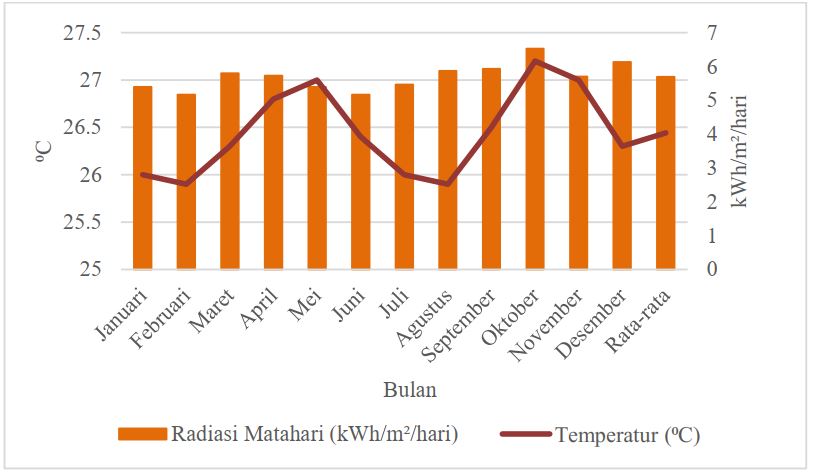THE DESIGN OF HYBRID RENEWABLE ENERGIES UTILIZATION TO INCREASE ELECTRIFICATION RATIO (CASE STUDY: TULAKAN, PACITAN REGENCY)
DOI:
https://doi.org/10.51401/altron.v2i02.2766Keywords:
Off-grid, HomerPro, Photovoltaic, Wind Turbine, BiogasAbstract
One of the lowest electrification ratios in Indonesia is in Pacitan Regency, East Java province, especially in the Tulakan sub-district. In contrast, the potency of renewable energy is plentiful and could be useful for the region nearby. Tulakan sub-district has a high potential for solar energy, wind energy, and biogas that can be developed for the residents to increase their electricity based on their needs. This research aims to simulate renewable energies (solar, wind, and biogas) available in Tulakan to gain the best configuration. Using HomerPro software, a suitable and feasible off-grid configuration combination can be created based on the available renewable energy resources. Based on the simulation that had been done, the result shows one best configuration that combined Photovoltaic, Wind Turbine, and Biogas. This configuration produces electricity up to 11.590 kWh/year, the highest contributor in producing energy from Wind Turbines at 65,9%, followed by Photovoltaic with a total of 25% and biogas with a total of 9,1%. This configuration still produces CO2 emissions from the biogas generator with a total of 1.324 kg/year and the number of initial investments for this configuration reached Rp 2.317.119.450. Furthermore, implementing this configuration could increase the electrification ratio to 100%.
References
Kementerian Energi dan Sumber Daya Mineral, Statistika Ketenagalistrikan 2019, Jakarta: Sekretariat Jenderal
Ketenagalistrikan, 2019.
D. Infield dan F. Leon, Renewable Energy in Power Systems, United Kingdom: Wiley, 2020.
E. Jaen, “Rasio Elektrifikasi di Wilayah Jawa Timur telah Mencapai 98,8 Persen,” rri.co.id, 2020. [Online]. Available:
[Diakses Desember 2022].
Badan Pusat Statistik Kabupaten Pacitan, “Kabupaten Pacitan Dalam Angka 2020,” Badan Pusat Statistik, Kabupaten
Pacitan, 2020.
Bappeda Kabupaten Pacitan, Potensi dan Pengembangan Energi Baru Terbarukan di Kabupaten Pacitan, Kabupaten
Pacitan: Pemerintah Kabupaten Pacitan, 2021.
B. U. Kansara dan B. R. Parekh, “Modelling and simulation of distributed generation system using HOMER software,”
International Conference on Recent Advancements in Electrical, Electronics, adn Control Engineering, 2011.
A. Hiendro, R. Kurnianto, M. Rajagukguk, Y. M. Simanjuntak dan Junaidi, “Techno-economic analysis of
photovoltaic/wind hybrid system for onshore/remote area in Indonesia,” Energy, Energy.
I. A. Wibowo dan D. Sebayang, “Optimization of Solar-Wind-Diesel Hybrid Power System Design using HOMER,”
International Journal of Innovation in Mechanical Engineering and Advanced Materials, 2015.
R. Srivastava dan V. K. Giri, “Optimization of hybrid renewable resources using HOMER,” 2016.
N. Tutkun, O. Can dan A. Afandi, “Low Cost Operation of an Off-grid Wind-PV System Electrifying Residential
Homes through Combinatorial Optimization by the RCGA,” 5th International Conference of Electrical, Electronics
and Information Engineering (ICEEIE), 2017.
Z. Smara, A. Laldji, A. Ferkous, M. Tali, A. Mahrane dan R. Dizene, “Evaluation of the self sufficiency of a home
powered by a PV–Wind system,” 2018 International Conference on Applied Smart Systems (ICASS), 2018.
A. Soba, V. A. Suoth dan H. S. Kolibu, “Optimasi Kapasitas Pembangkit Listrik Tenaga Hybrid (PLTH) di Pulau
Bunaken menggunakan Software HOMER,” Jurnal MIPA, 2019.
M. Rumbayan dan Y. Nakanishi, “Prospect of PV-Wind-Diesel Hybrid System as an Alternative Power Supply for
Miangas Island in Indonesia,” International Journal of Smart Grid and Clean Energy, 2019.
L. Lozano, E. Querikiol, M. Abundo dan L. Bellotindos, “Techno-economic Analysis of a Cost-Effective Power
Generation System for Off-Grid Island Communities,” Renewable Energy, 2019.
M. H. Jahangir dan R. Cheraghi, “Economic and Environmental Assessment of Solar-Wind-Biomass Hybrid
Renewable Energy System Supplying Rural Settlement Load,” Sustainable Energy Technologies and Assessments,
A. Verma dan B. Singh, “Integration of Solar PV-WECS and DG Set for EV Charging Station,” 2020 IEEE
International Conference on Power Electronics, Smart Grid, and Renewable Energy (PESGRE2020), 2020.
Kementerian Energi dan Sumber Daya Mineral, Panduan Studi Kelayakan Pembangkit Listrik Tenaga Surya Terpusat,
Indonesia: USAID, 2018.
Direktorat Jendral EBTKE ESDM, LKJ DITJEN EBTKE 2018, Indonesia: Kementerian Energi dan Sumber Daya
Mineral, 2018.
Kementerian Energi Sumber Daya dan Mineral, Panduan Studi Kelayakan Pembangkit Listrik Tenaga Surya Terpusat,
Jakarta: United States Agency International Development (USAID), 2018

Published
How to Cite
Issue
Section
Copyright (c) 2023 Sri Anggoro Prahastono, Ahmad Agus Setiawan, Wahyu Wilopo

This work is licensed under a Creative Commons Attribution 4.0 International License.






